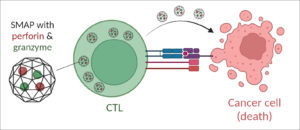Supramolecular Attack Particles (SMAPs) – Nanoparticles from killer T cells engineered for immunotherapeutic use

Applications: Therapeutics, oncology, immunotherapy
SMAPs are particles released from cytotoxic T lymphocytes (CTLs) that autonomously kill target cells. They can be engineered to deliver cargoes and functionalised to target specific organs or cells.
| Features | Benefits |
|
|
|
|
|
|
|
|
|
|
about this technology
© Oxford University Innovation

